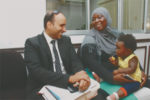Mona Sahlin, leader of the Swedish Social Democratic party (SAP), is known by many names among her opponents. Though Sahlin is not Muslim, one of the most common nicknames for her is “Mona Muslim.” This appellation might suggest a cartoon character, or perhaps a Sesame Street muppet, but behind it lies a deepening anxiety about levels of immigration in Sweden, which has been profitably tapped into and exploited by right-wing political leaders.
Sahlin’s nickname goes back some time, with one of the most frequently cited incidents being her visit as Integration Minister to a mosque a few days after 9/11. It is now regularly used on blogs and political forums as a shorthand way of referring to everything anti-Sahlin.

Mona Sahlin on a visit to a mosque in Sweden.
Use of the word “Muslim” as a politically-charged slur was given what is perhaps its most high-profile run to date during U.S. President Obama’s campaign, with the turban photo and the word “madrassa” which, rather comically, kept cropping up at regular intervals. In Sahlin’s case, use of the nickname “Mona Muslim” is almost invariably accompanied by photographs of the SAP leader during a visit to a mosque (pictured right), with a scarf haphazardly wrapped around her head. “Allah ska med,” a modification of the party’s slogan “Alla ska med” (“all included”) is often provided as a self-explanatory caption.
As Obama faced charges of being a socialist, as well as being a Muslim, Sahlin is on the one hand identified with a stereotypically extreme leftist position (as a self-hating Swede who believes Sweden has no culture), and on the other hand, apparently a fascist; another of her nicknames is “Mona Stalin.”
The parallels highlight the convolutions of making politicians more radically leftist than they really are, while also associating them with totalitarianism and religious fundamentalism by invoking Islamophobia. This forked attack might be paradoxical, but it covers all the bases.
As a disclaimer, I should clarify that I’m no fan of either Obama or Sahlin. There are politically valid reasons for why Sahlin is often described as “unpopular,” not least the fact that many see her credibility as irreparably damaged by the Toblerone affair. But what does it mean that these political grievances are repackaged through the caricature figure Mona Muslim?
There are of course the usual eccentrics who are convinced of Sahlin’s secret “conversion” to Islam. However, unlike the smear campaign against Obama, few seriously pose the question of Sahlin’s faith. Instead the nickname works mainly to fuel fears over immigration, a critical and divisive issue in Sweden. Conjuring up the fear factor of Islamization, Mona Muslim seems to provide the ideal way to represent the threat of waking up to a world where the “blattar” have taken over – threatening not only jobs, but also Swedish culture.
The haphazard hijab Sahlin wore on several mosque visits provides a particularly easy target, frequently identified as a sign that Sahlin supports “women’s oppression.” The reason this argument works, illogical as it may seem, is that it represents a wider criticism of leftist politicians who “don’t understand” what they are dealing with.
While Sahlin’s opponents take every opportunity to criticize her for purportedly encouraging Islamization, they at the same time suggest that she is uninformed and/or misguided about the true extent of the danger Islam poses to liberal societies. For example, this post at Politiskt Inkorrekt cites Sahlin as saying “more mosques” should be built and then juxtaposes this with an image of Sahlin drinking, which the writer takes pains to point out would be prohibited in an Islamic state.
There’s an astonishing leap of logic accomplished here, equating the construction of a religious site with calling for the establishment of a religious state. But looking too deeply into the logic would be to miss the point, which is clearly to highlight Sahlin’s dangerous naïveté as regards Islam.
Handily, this then provides the perfect space for self-styled experts to expound on their favorite subject, the growing threat of a growing Muslim population. In Sweden, there are countless blogs and sites dedicated to documenting this dangerous phenomenon, while in Norway, they have coined the phrase snikislamisering (sneak Islamization) to encapsulate exactly this sense of a creeping, secretive infection spreading through the land.
In the past couple of years, there has been a marked rise in the popularity of right-wing and far-right parties in Sweden, in particular the Swedish Democrats, with a record number of Swedes saying they will vote for them in the general elections this year. Unsurprisingly, Mona Muslim has figured as a potent weapon in the right’s attempt to refashion themselves as the vigilant vanguard fighting for Sweden’s Swedishness. Marshaling Islamophobia is, it seems, always an effective way of representing the left as ineffectual, and encouraging people to vote “right.”


